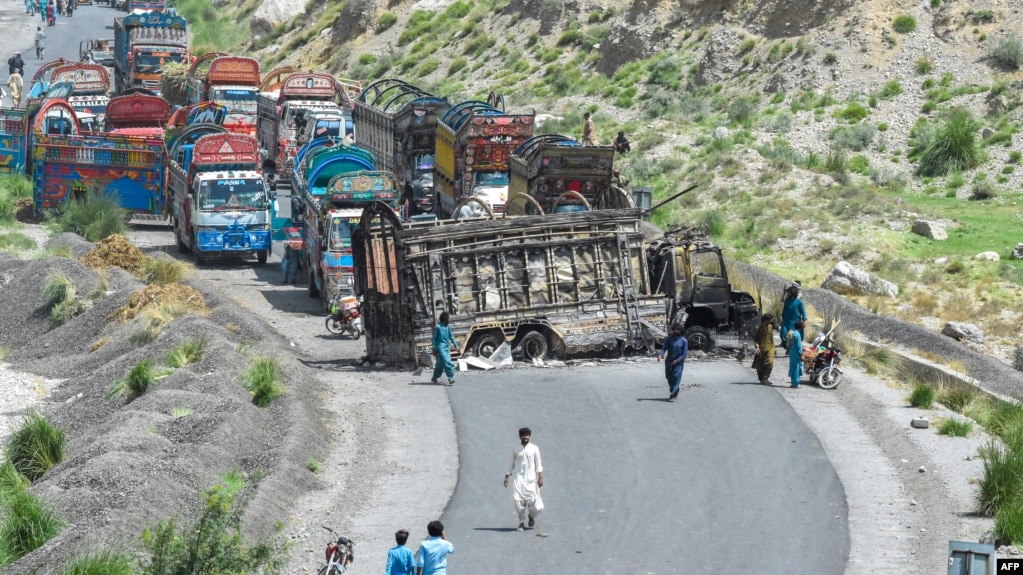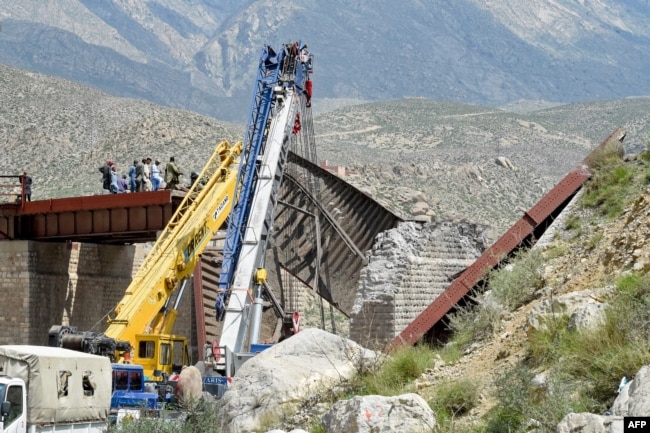September 01, 2024
By Abubakar Siddique

By Abubakar Siddique

People look at a charred vehicle near a collapsed railway bridge a day after a blast by separatist Baloch Liberation Army militants at Kolpur in Bolan district, Balochistan Province, on August 27.
The Baloch Liberation Army (BLA) has waged an over 20-year insurgency against the Pakistani state, carrying out mostly small-scale attacks against government forces.
But that changed last week when the separatist militant group claimed responsibility for major coordinated attacks across the vast and impoverished southwestern province of Balochistan, killing over 70 people.
The bombings and shootings on August 25-26 were the deadliest in years in Balochistan, which borders Afghanistan and Iran and is home to Pakistan’s Baluch ethnic minority.
Experts say the attacks highlight the growing strength of the BLA, which has boosted its recruitment and gained access to modern weapons. The U.S.-designated terrorist group has also adopted more lethal tactics like suicide bombings in recent years.
“These attacks were unprecedented and mark a new escalation in the tensions in Balochistan,” said Kiyya Baloch, a Pakistani journalist and commentator who tracks militancy in the region. “It shows the BLA’s determination to showcase its growing strength.”
Demonstrating Dominance
In an operation that began late on August 25, BLA fighters bombed a railway bridge linking the province to the rest of Pakistan, attacked police and military posts, and targeted buses and trucks on a major highway.
In the deadliest attack, BLA fighters stopped a bus and shot dead 23 of its passengers, many of whom were from Punjab, Pakistan's most populous and prosperous province.
The coordinated attacks coincided with the anniversary of the death of Baloch nationalist leader Akbar Bugti, who was killed by Pakistan's security forces in 2006.

But that changed last week when the separatist militant group claimed responsibility for major coordinated attacks across the vast and impoverished southwestern province of Balochistan, killing over 70 people.
The bombings and shootings on August 25-26 were the deadliest in years in Balochistan, which borders Afghanistan and Iran and is home to Pakistan’s Baluch ethnic minority.
Experts say the attacks highlight the growing strength of the BLA, which has boosted its recruitment and gained access to modern weapons. The U.S.-designated terrorist group has also adopted more lethal tactics like suicide bombings in recent years.
“These attacks were unprecedented and mark a new escalation in the tensions in Balochistan,” said Kiyya Baloch, a Pakistani journalist and commentator who tracks militancy in the region. “It shows the BLA’s determination to showcase its growing strength.”
Demonstrating Dominance
In an operation that began late on August 25, BLA fighters bombed a railway bridge linking the province to the rest of Pakistan, attacked police and military posts, and targeted buses and trucks on a major highway.
In the deadliest attack, BLA fighters stopped a bus and shot dead 23 of its passengers, many of whom were from Punjab, Pakistan's most populous and prosperous province.
The coordinated attacks coincided with the anniversary of the death of Baloch nationalist leader Akbar Bugti, who was killed by Pakistan's security forces in 2006.

Railway officials inspect the remains of a collapsed railway bridge the morning after a blast by separatist militants at Kolpur in Bolan district, Balochistan Province, on August 27.
Aziz Baloch, an independent security expert in Balochistan, said the BLA is keen “to demonstrate that it can demoralize the [Pakistani] Army” and establish itself as the “dominant militant group” in the province.
Balochistan has been the scene of a low-level insurgency and a brutal army crackdown for decades.
The BLA and other separatist Baluch groups seek independence from Pakistan, which they blame for exploiting the vast natural resources in Balochistan and committing grave human rights abuses in the region.
The BLA is considered the largest armed group operating in Balochistan. Experts believe the BLA has several thousand members.
Researchers have documented a sharp increase in the number of attacks carried out by Baluch groups so far this year.
Better Guns, Deadlier Tactics
Experts say the BLA has become a more organized and increasingly potent fighting force.
Pakistani militant groups, including the BLA, are believed to have obtained American weapons and military equipment. When U.S. and international forces pulled out of Afghanistan in 2021, they left behind billions of dollars’ worth of military gear and weapons that were then seized by the Taliban after it captured power.
“Its acquisition of modern weapons has enhanced BLA’s combat capabilities,” said Baloch, the journalist and commentator.
Baloch added that the BLA, a secular group, has also adopted more lethal tactics used by Islamist militant groups like the Afghan Taliban and the Tehrik-e Taliban Pakistan, also known as the Pakistani Taliban.
They include the use of suicide bombings, improvised explosive devices, or IEDs, and so-called complex attacks involving multiple attackers and vehicle-borne IEDs.
The Majeed Brigade, the BLA’s suicide squad, is believed to have carried out most of the group’s complex attacks.
In 2022, a 31-year-old mother became the first woman to carry out a suicide bombing for the BLA. The move was considered a “paradigm shift” by some observers.
Exploiting Local Anger
Experts say local factors have also strengthened the BLA.
Baloch, the security expert in Balochistan, said the BLA has been successful in recruiting Baluch youth. Around 65 percent of Balochistan’s population of 15 million are under the age of 30.

Aziz Baloch, an independent security expert in Balochistan, said the BLA is keen “to demonstrate that it can demoralize the [Pakistani] Army” and establish itself as the “dominant militant group” in the province.
Balochistan has been the scene of a low-level insurgency and a brutal army crackdown for decades.
The BLA and other separatist Baluch groups seek independence from Pakistan, which they blame for exploiting the vast natural resources in Balochistan and committing grave human rights abuses in the region.
The BLA is considered the largest armed group operating in Balochistan. Experts believe the BLA has several thousand members.
Researchers have documented a sharp increase in the number of attacks carried out by Baluch groups so far this year.
Better Guns, Deadlier Tactics
Experts say the BLA has become a more organized and increasingly potent fighting force.
Pakistani militant groups, including the BLA, are believed to have obtained American weapons and military equipment. When U.S. and international forces pulled out of Afghanistan in 2021, they left behind billions of dollars’ worth of military gear and weapons that were then seized by the Taliban after it captured power.
“Its acquisition of modern weapons has enhanced BLA’s combat capabilities,” said Baloch, the journalist and commentator.
Baloch added that the BLA, a secular group, has also adopted more lethal tactics used by Islamist militant groups like the Afghan Taliban and the Tehrik-e Taliban Pakistan, also known as the Pakistani Taliban.
They include the use of suicide bombings, improvised explosive devices, or IEDs, and so-called complex attacks involving multiple attackers and vehicle-borne IEDs.
The Majeed Brigade, the BLA’s suicide squad, is believed to have carried out most of the group’s complex attacks.
In 2022, a 31-year-old mother became the first woman to carry out a suicide bombing for the BLA. The move was considered a “paradigm shift” by some observers.
Exploiting Local Anger
Experts say local factors have also strengthened the BLA.
Baloch, the security expert in Balochistan, said the BLA has been successful in recruiting Baluch youth. Around 65 percent of Balochistan’s population of 15 million are under the age of 30.

Pakistani soldiers inspect a collapsed railway a day after a blast by separatist BLA militants at Kolpur in Bolan district, Balochistan Province, on August 27.
“They have a lot of manpower and have been attracting female [recruits], too,” he said.
Baloch, the journalist and commentator, said poverty, high unemployment, alleged abuses by the authorities, and political suppression have made Balochistan a “fertile ground for the BLA to attract and recruit more youth.”
Many BLA leaders and fighters are former trained professionals and university students.
Observers say Pakistan has resorted to brute force to crush successive Baluch insurgencies and ignored the long-standing grievances of the Baluch ethnic minority.
“The BLA is a manifestation of the state’s failure to manage and govern Balochistan,” said Baloch, the security expert.
Abdul Malik Baloch, a politician and former chief minister of Balochistan, said many Baluch are becoming increasingly disillusioned with what they call Islamabad’s political meddling in the province.
Baloch said rigged elections in Balochistan aimed at empowering pro-Islamabad figures have disenchanted those who believe in “peaceful politics.”
“Political activists tell me that democracy here is a fraud,” he said. “They feel we are wasting their time.”
Abdul Malik Baloch, who leads the secular National Party, was among several prominent Baluch leaders who lost their seats in parliamentary elections in February. The lawmaker remains a member of the provincial assembly.
Opposition figures accused Pakistan’s powerful military, which has an oversized role in the domestic and foreign affairs of the country, of rigging the vote.
“Disappointment is pushing people into the arms of the insurgency,” said Baloch, the former chief minister.

Abubakar Siddique a journalist for RFE/RL's Radio Azadi, specializes in the coverage of Afghanistan and Pakistan. He is the author of The Pashtun Question: The Unresolved Key To The Future Of Pakistan And Afghanistan. He also writes the Azadi Briefing, a weekly newsletter that unpacks the key issues in Afghanistan.
No comments:
Post a Comment